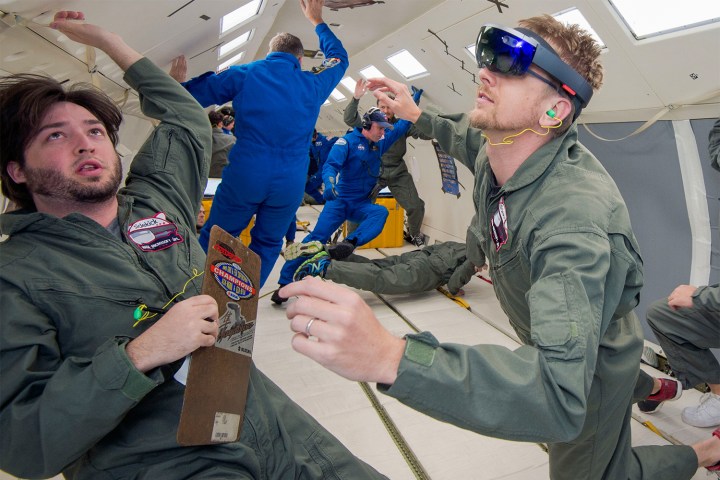
Jeff Norris, mission operations innovation lead at the NASA Jet Propulsion Laboratory, told Digital Trends that his lab has active partnerships with almost every company that makes a device you can put on your head, including Valve, HTC, Microsoft, Sony, Oculus, Samsung, and others.
From your PlayStation 4, to outer space
“The difference in our work due to the consumer electronics industry’s investment in VR and AR has been profound for us,” Norris said. “It has unlocked opportunities for our work that weren’t available before.”
“We can make astronauts feel they’re really present [where] they’re going to be exploring.”
Even before Sony launched PlayStation VR at retail, Norris had early versions of the device – back when it was called Project Morpheus – being used in tests to control the Robonaut 2 (R2) humanoid robot, which is currently on board the International Space Station.
“PlayStation VR allows us to more naturally control a humanoid robot,” Norris said. “It’s as natural as moving your own hand.”
In addition to R2, astronauts aboard the International Space Station utilize a pair of Microsoft HoloLens AR headsets as part of Project Sidekick. Norris’ team is using AR to augment the performance of astronauts working in space.
“We’re constantly working with our partners to use the unique features of these devices to map those into the unique elements of the problems we’re trying to solve,” Norris said. “Different manufacturers are doing different things. We want to see these platforms diversifying and exploring this domain, because we benefit by using their devices.”
NASA is actively looking for new technology, as well. The space agency had its first booth at the Consumer Electronics Show (CES) in Las Vegas this past January. It also sends representatives to video game shows like the Game Developers Conference (GDC) in San Francisco, and the Electronic Entertainment Expo (E3) in Los Angeles.
Reach out and touch someone
Bob Vlemmix, co-founder of Manus VR, said NASA began working with the company’s data gloves this past March. The gloves replicate your hands in VR, AR and mixed reality environments, allowing the user to work across enterprise, entertainment and gaming landscapes.
“Manus VR sees a market where both NASA, and your average gamer, have access to the same cutting-edge technology.”
NASA is using a prototype version the gloves, which aren’t available to the public yet, to help train astronauts before they head to the International Space Station. NASA uses the data gloves with the Vive. It has built mock-up rooms on Earth that replicate the layout of the International Space Station. Astronauts are able to navigate virtual spaces and pick up and use tools, just as they would in space.
“By recreating physical locations in VR, you can simulate environments that are not easily accessible, or require extensive training,” Vlemmix said.
Vlemmix said that just a few years ago data gloves cost thousands of dollars and were a commodity only available to big institutions. Now, consumer products in virtual reality have outdone the bulky, expensive hardware of the past in both cost and performance.
“Manus VR is creating a market where both NASA and your average gamer have access to the same cutting-edge technology,” Vlemmix said.
In addition to developing a consumer glove, Manus VR is adding support for SteamVR Tracking through a tracking bracelet that will provide the Manus VR gloves with positional tracking for each trainee’s hands and arms. Vlemmix said the Manus VR gloves will work across VR and AR devices, including HoloLens, and support for additional platforms will be added in the future.
Journey to Mars, sooner than expected
VR is also helping NASA plan its first exploration of Mars is the 2030s. Norris’ team has used the Oculus Rift to train astronauts how to operate rovers on Mars more effectively.
“Because I work in mission operations, my team has been involved in how things are going on Mars, and how things are accomplished,” Norris said. “We have this new medium that we can make astronauts feel like they’re really present in these environments that they’re going to be exploring. What does it look like standing on a hilltop on Mars? What does it feel like to be on the space station? These are the questions in so many people’s minds, and VR is a way we can answer them.”
NASA, through a partnership with television network Fusion, is also bringing the Red Planet home for anyone to explore. The Mars 2030 Experience will launch across Oculus Rift, Google Cardboard, Samsung VR Gear, iOS and Android, although no release date has been given yet.
Using Unreal Engine 4, MIT and Fusion are collaborating with NASA to create a 7.7 square mile interactive environment on Mars that players can traverse on foot or by rover. The experience features actual topography, authentic gravity, and real lighting, as well as authentic missions based on things astronauts will one day do on the planet.
“The Mars 2030 Experience is focused on a public outreach and engagement to share the experience,” Norris said. The rover, the habitat modules, the labs, and everything else is based on actual CAD models provided by NASA.
“We don’t have nearly as much data on the topology of Mars as we do of Earth,” Justin Sonnekalb, a technical designer at Irrational Games who is working on this project, said. “Recreating the planet’s surface is a painstaking process based on multiple (and occasionally slightly conflicting) data sets, which had to be added to the terrain system, interpolated, and then manually adjusted to match the feel of the reference shots.”
And this is just the beginning of how NASA can benefit from the VR and AR technology entering living rooms around the world. Decades ago, people across the globe watched astronauts step foot on the moon through their televisions. When humans first step on Mars, we might be right there with them – in VR.


